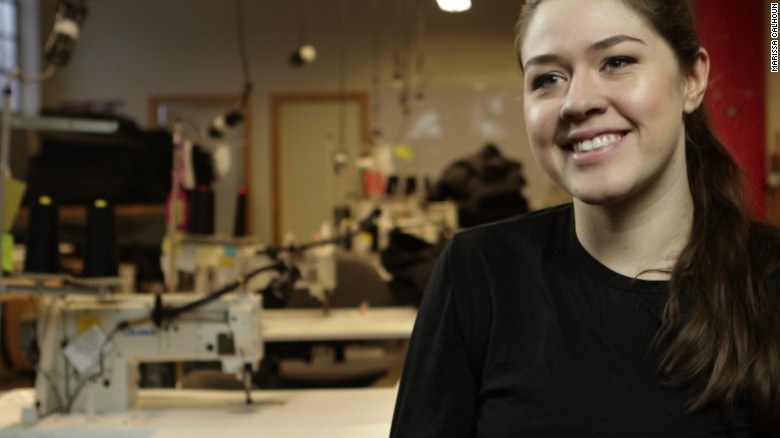Six years ago, Veronika Scott accepted a challenge from her college professor: Design something to “fill a need” in Detroit.
Scott, an art student, found her inspiration on the streets.
“In Detroit, there’s this large homeless population, and they kind of just disappear into the landscape,” Scott said. “I wanted to design for this whole population of people that we just don’t see.”
In 2010, Scott created a fully insulated, waterproof jacket that converts into a sleeping bag and knapsack. She called it the EMPWR coat.
“So many people on the streets are wearing somebody else’s trash,” said Scott, now 26. “The coat itself was meant to offer people warmth…but also to give them a little bit of pride.”
But Scott’s work was far from finished. As she handed out the coats one day, a woman in a shelter shouted, “We don’t need coats. We need jobs.”
Today, Scott and her nonprofit, the Empowerment Plan, hire homeless individuals from local shelters to help manufacture the coats. Employees receive training and other support services to help them get their lives back on track.
Since 2012, the group has made and distributed more than 15,000 free coats for the homeless nationwide and around the world.
CNN’s Marissa Calhoun spoke with Scott about her work. Below is an edited version of their conversation.
CNN: You started your nonprofit right after graduating college. How did people react?
Scott: I was surprised by the fact that everybody told me I was going to fail because I wanted to go into shelters and hire people. One person said, point blank: “You’re never going to get a homeless person to make a peanut butter and jelly sandwich, let alone a coat.” And for me, that was the most shocking thing because that’s not true at all.
Today, Empowerment Plan employs 22 previously homeless parents. And (they) are absolutely, mind-blowingly amazing. So if there was a weak point in my business plan, it sure as hell wasn’t me employing them.
For us, it’s about showing employers that the people we hire aren’t just good for us, they are an asset to any company—it’s just about looking beyond what’s on paper.
CNN: How do you find them?
Scott: It all starts with going into the shelters and saying, “We have this job opportunity.” And then from there we have a very rigorous three-part interview process to identify who’s going to succeed here.
We look for people that are going to make the culture better, people that are going to invest in the organization and take ownership of it. It’s a big deal to us to find the right individuals. What it really comes down to is motivation—that the biggest motivating factor and what gets people up in the morning isn’t just getting a paycheck, but creating that better life for their family.
We’re (also) bridging that gap between the shelter and being financially independent and stable. We shut down our production day at 3 o’clock and allow our employees to stay on the clock, so they are earning an income while they study for their GED, take financial literacy classes or participate in leadership development.
CNN: The decision to hire parents is very personal for you.
Scott: Growing up, both my parents struggled with unemployment and addiction. We were constantly moving around. When you’re raised in someone else’s rock bottom, it shapes how you look at the world. For me, it was really difficult. I wanted to create an opportunity that I wish my parents had when I was a kid.
On average, for every one person we hire, they have two to three kids. We hope that this changes the trajectory of how those children are raised. If your parent isn’t stressed about money because they are employed and they can provide consistency for you, that has a huge impact. This opportunity doesn’t just help the parents, it pulls their kids out of that situation, too.
CNN: Beyond your initial idea, how has the city of Detroit influenced your work?
Scott: My grandparents are from Detroit. My great-grandparents are from Detroit. So coming here to go to college had a lot of meaning.
When I first started Empowerment Plan, this community was there to support me in doing this, helping me craft something from nothing. It was amazing how individuals in this area that are chronically homeless were helping me create something to fill a need they have—all the way to giant corporations here that normally would not pay attention to a design student with an idea about making coats.
There’s this whole community that has been here from the beginning that wants to see it succeed because they’ve weathered all of the storms that this city has gone through.
Want to get involved? Check out the Empowerment Plan website at www.empowermentplan.org and see how to help.



